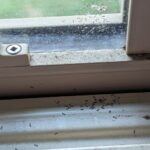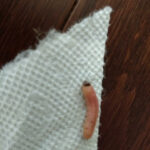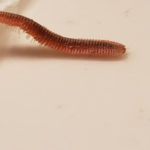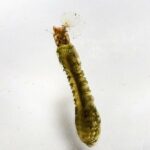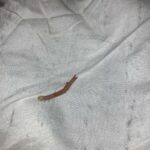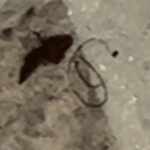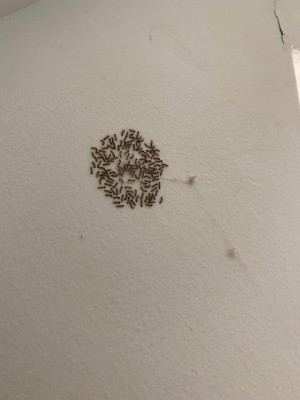
Clusters of small, dark worm-like creatures have been found by this reader in the UK, who would like to know what these critters are. Our reader reports finding two such clusters in her house, both times finding them “high up on walls”, and describes them as being the size of a “50p coin” (slightly larger than a quarter).
Well, we might as well jump right in. Thanks to the excellent photograph our reader sent in, which we thank her for, we have identified these creatures as the newly-hatched larvae of the fall armyworm moth. Commonly referred to as FAW, the fall armyworm is a well known, albeit infamous larva. Although the fall armyworm is but the caterpillar stage of the fall armyworm moth, it is far better known for this stage than its adult stage. We should assure our reader, however, that the armyworm is not infamous for reasons of infesting homes and causing trouble (though it is clearly possible), or for the reason that they are dangerous or parasitic (as they are not), but because they are one of the worst pests a farmer could deal with.
The fall armyworm is native to the Western United States, but is also found in the Africas and in Europe. The key thing one can look out for to identify armyworms is the large numbers by which they hatch and travel together, hence the name ‘army’. Like an army, these creatures will march through crop fields to eat through the foliage of every and any plant they can find. They are voracious eaters, and in their large numbers, they can cause significant damage. In fact, the Food and Agricultural Organization of the United States launched an initiative called ‘Global Action for Fall Armyworm Control’ in December 2019 because their negative impact on agriculture had become so extensive.
So, why did our reader find clusters of fall armyworms on her ceiling? Despite FAW preferring to roam through forests and farms and wreak utter havoc, they have been known to sometimes appear in homes. In the case of our reader, we are guessing that the mother moth(s) flew into the house through an open window or door in search of shelter, and thought the upper walls of our reader’s house would make a safe and comfortable space for her larvae to hatch. Fortunately for our reader, she found the armyworms right after hatching, and so, as we can see, they are already grouped together and easy to remove from the home. Simply putting them in a container of sorts with air holes for breathing, and moving them to a nearby forest or similar area with lots of foliage should suffice in dealing with the lot of them. The worst these armyworms might do inside a house is eat the leaves of the houseplants, but they will not be attracted to this home for any reason, as it is not their natural habitat. Our reader should just make sure there are no cracks or gaps in her home through which the likes of any insect or worm could fly or crawl.
To conclude, the two clusters of larvae our reader found on the walls of her house are newly-hatched fall armyworms. Though they are abhored by farmers (for good reason), our reader has nothing to fear from these armyworms, and given that she caught them at a good stage, they will be easy to remove from her home. We hope this article was of help to our reader, and the best of luck to her!
All About Worms is always free, always reader-supported. Your tips via CashApp, Venmo, or Paypal are appreciated! Receipts will come from ISIPP Publishing.
You might also find these guys interesting!





